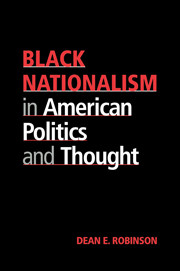Book contents
- Frontmatter
- Contents
- Acknowledgments
- Introduction
- 1 Anglo-African Nationalism
- 2 Malcolm X and the Nation of Islam
- 3 Black Nationalist Organizations in the Civil Rights Era
- 4 Black Nationalist Discourse
- 5 Black Nationalism as Ethnic Pluralism
- 6 Black Nationalism and the Ethnic Paradigm
- 7 Black Nationalism in the Contemporary Era
- Notes
- Selected Bibliography
- Index
3 - Black Nationalist Organizations in the Civil Rights Era
Published online by Cambridge University Press: 12 January 2010
- Frontmatter
- Contents
- Acknowledgments
- Introduction
- 1 Anglo-African Nationalism
- 2 Malcolm X and the Nation of Islam
- 3 Black Nationalist Organizations in the Civil Rights Era
- 4 Black Nationalist Discourse
- 5 Black Nationalism as Ethnic Pluralism
- 6 Black Nationalism and the Ethnic Paradigm
- 7 Black Nationalism in the Contemporary Era
- Notes
- Selected Bibliography
- Index
Summary
In order to understand the rise and significance of black nationalist groups of the 1960s, we must first grasp three important features of the political context of that era of black politics. One development involved the struggle for racial equality, embodied in the efforts of such groups as the National Association for the Advancement of Colored People (NAACP), the Southern Christian Leadership Conference (SCLC), the Congress of Racial Equality (CORE), and the Student Nonviolent Coordinating Committee (SNCC). The “black mass protests and insurgencies of the 1950s and 1960s,” however, “were grassroots movements that emerged with little guidance from national African-American organizations or their leaders.” These movements held center stage in a postwar drama holding a captive American audience who had recently faced the horror of Nazism and who, especially in the context of the cold war era, had slowly begun to reexamine the question of racial inequality in the United States. The moderate success of the civil rights movement initiated, in turn, an important shift in the course of black politics. The call for Black Power in 1966 indicated a change in strategic orientation, and in movement demands.
Second, this ideological reorientation took on even greater significance in the context of the unrest that shook urban areas large and small during the 1960s. Prior to the uprising surrounding the Rodney King incident in 1995, the Watts riot of 1965 stood as the most destructive in U.S. history. More than 300 riots took place between 1964 and 1968, more than 100 following the assassination of Martin Luther King, Jr., alone.
- Type
- Chapter
- Information
- Black Nationalism in American Politics and Thought , pp. 51 - 69Publisher: Cambridge University PressPrint publication year: 2001

